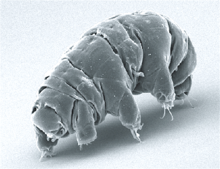Soil mesofauna are invertebrates between 0.1mm and 2mm in size,[1] which live in the soil or in a leaf litter layer on the soil surface. Members of this group include nematodes, mites, springtails (collembola), proturans, pauropods, rotifers, earthworms, tardigrades, small spiders, pseudoscorpions, opiliones (harvestmen), enchytraeidae such as potworms, insect larvae, small isopods and myriapods.[2] They play an important part in the carbon cycle and are likely to be adversely affected by climate change.[3]


Diet and effects on soil
editSoil mesofauna feed on a wide range of materials including other soil animals, microorganisms, animal material, live or decaying plant material, fungi, algae, lichen, spores, and pollen.[4] Species that feed on decaying plant material open drainage and aeration channels in the soil by removing roots. The fecal material of soil mesofauna remains in channels that can be broken down by smaller animals.
Soil mesofauna do not have the ability to reshape the soil and, therefore, are forced to use the existing pore space in soil, cavities, or channels for locomotion. Soil Macrofauna, earthworms, termites, ants, and some insect larvae, can make the pore spaces and hence can change the soil porosity,[5] one aspect of soil morphology. Mesofauna contribute to habitable pore spaces and account for a small portion of total pore spaces. Clay soils have much smaller particles which reduce pore space. Organic material can fill small pores. Grazing of bacteria by bacterivorous nematodes and flagellates, soil mesofauna living in the pores, may considerably increase Nitrogen mineralization because the bacteria are broken down and the nitrogen is released.[6]
In agricultural soils, most of the biological activity occurs in the top 20 centimetres (7.9 in), the soil biomantle or plow layer, while in non-cultivated soils, the most biological activity occurs in top 5 centimetres (2.0 in) of soil. The top layer is the organic horizon or O horizon, the area of accumulation of animal residues and recognizable plant material. Animal residues are higher in nitrogen than plant residues with respect to the total carbon in the residue.[7] Some Nitrogen fixation is caused by bacteria which consume the amino acids and sugar that are exuded by the plant roots.[8] However, approximately 30% of nitrogen re-mineralization is contributed by soil fauna in agriculture and natural ecosystems.[9] Macro- and mesofauna break down plant residues[10][11] to release Nitrogen as part of nutrient cycling.[12]
Reproduction
edit[edit] Many species of mesofauna reproduce in a variety of ways. Non-arthropod species such as nematodes and potworms can reproduce both sexually and asexually, the nematode through parthenogenesis which only creates females, and the potworm through whole-body regeneration. Soil rotifers another non-arthropod mesofauna, are only female and reproduce using unfertilized eggs. Arthropod species of soil mesofauna such as thrips, springtails, and pauropods reproduce solely by parthenogenesis. Diplurians and mites reproduce sexually, but some species of mites can reproduce by parthenogenesis. Some species of soil mesofauna are susceptible to soil and vegetation changes because they rely on soil fertility and plant biomass for food and comfortable living conditions. The changes can affect some species' ability to reproduce, but since there are many variations in the species of soil mesofauna, the changes won’t affect all. For mesofauna such as springtails temperature and soil moisture influence the reproduction and growth rates of the individuals.
References
edit- ^ "Macrofauna and Mesofauna". National Soil Resources Centre, UK. Retrieved 2012-09-07.
- ^ "A Chaos of Delight". A Chaos of Delight. 2021-02-16. Retrieved 2024-10-22.
- ^ Seeber, Julia (2012). "Drought-induced reduction in uptake of recently photosynthesized carbon by springtails and mites in alpine grassland". Soil Biology & Biochemistry. 55 (December): 37–39. doi:10.1016/j.soilbio.2012.06.009. PMC 3458213. PMID 23209331. 0038-0717.
- ^ "Collembola: springtails". Commonwealth Scientific and Industrial Research Organisation (CSIRO), Australia. Retrieved 2012-09-08.
- ^ Sparks, Donald (2017). Advances in Agronomy. City: Academic Pr. ISBN 978-0-12-812415-4.
- ^ Hassink, J.; Bouwman, L.A.; Zwart, K.B.; Brussaard, L. (1993). "Relationships between habitable pore space, soil biota and mineralization rates in grassland soils". Soil Biology and Biochemistry. 25 (1): 47–55. doi:10.1016/0038-0717(93)90240-C. ISSN 0038-0717.
- ^ House, G. J.; Stinner, B. R.; Crossley, D. A.; Odum, E. P. (1984). "Nitrogen Cycling in Conventional and No-Tillage Agro-Ecosystems: Analysis of Pathways and Processes". The Journal of Applied Ecology. 21 (3): 991. doi:10.2307/2405063. ISSN 0021-8901. JSTOR 2405063.
- ^ Trolldenier, G. (1987). "Curl, E.A. and B. Truelove: The Rhizosphere. (Advanced Series in Agricultural Sciences, Vol. 15) Springer-Verlag, Berlin-Heidelberg-New York-Tokyo, 1986. 288 p, 57 figs., Hardcover DM 228.00, ISBN 3-540-15803-0". Zeitschrift für Pflanzenernährung und Bodenkunde. 150 (2): 124–125. doi:10.1002/jpln.19871500214. ISSN 0044-3263.
- ^ Elliott, E.T.; Coleman, David C. (c. 1988). "Let the Soil Work for Us". Ecological Bulletins (39): 23–32. JSTOR 20112982.
- ^ Badejo, M. Adetola; Tian, Guanglong; Brussaard, Lijbert (1995). "Effect of various mulches on soil microarthropods under a maize crop". Biology and Fertility of Soils. 20 (4): 294–298. doi:10.1007/BF00336093. ISSN 0178-2762. S2CID 36728358.
- ^ Gobat, J-M; Aragno, M; Matthey, W (c. 2010). "The living soil. Bases of soil science". Soil Biology.
- ^ Swift, M. J. (1979). Decomposition in terrestrial ecosystems. Oxford: Blackwell. ISBN 978-0-632-00378-5.